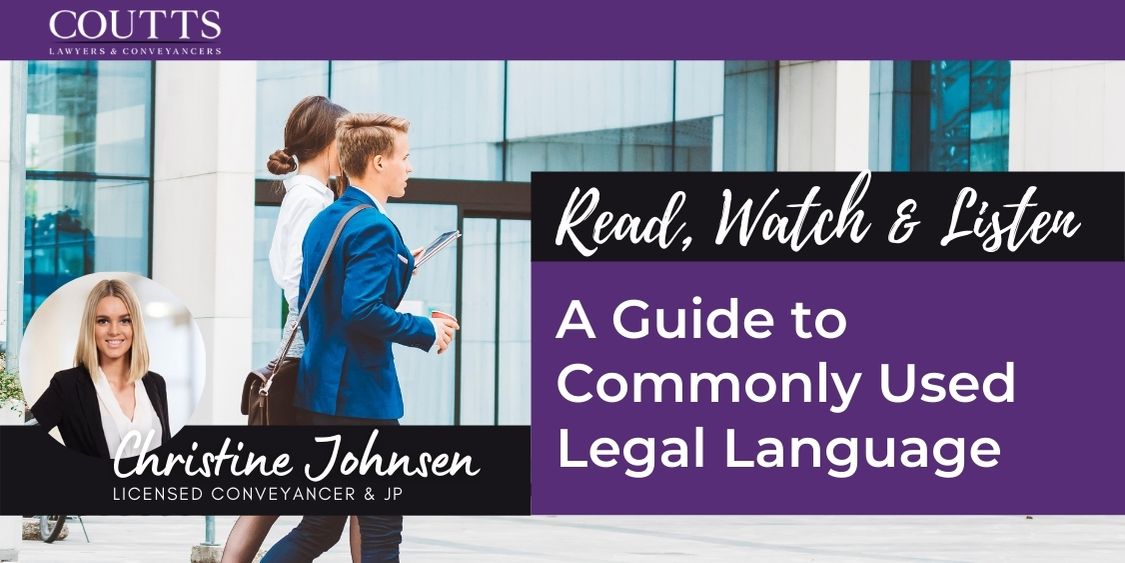Co-written by Kay Vitogiannis
KEY TAKE-OUTS:
The process when selling or buying a property can be daunting, especially when you are thrown legal language from your representative or agent which may not make sense to you.
To put you at ease, I have created a cheat sheet of the most common legal language used throughout the process of conveyancing.
- Cooling off period: A cooling-off period benefits a Purchaser as this period, which is usually either 5 or 10 business days from the exchange, allows time for the Purchaser to carry out their due diligence of the property and obtain their finance if required. During a cooling-off period, a Purchaser has the right of rescission should they no longer wish to proceed with the purchase. Should this occur, the Purchaser forfeits to the Vendor the 0.25% deposit they have paid in order to exchange in such cooling-off period. The Vendor does not have the reciprocal right.
- Exchange: Exchange of Contracts happens when both parties i.e. the Vendor and the Purchaser, both sign their counterpart Contract, and all is in order for an exchange to occur. Exchange means, the parties are locked into that Contract and their agreement is binding, whether it be in a cooling-off period, or unconditional. Once Contracts are exchanged, the process of preparing for the settlement can take place.
- Breach: When one party fails to perform its obligations under the contract within the time specified in the contract.
- Gazumping: Is when a Vendor accepts your offer to purchase a property, but then it is sold prior to an exchange occurring to someone else, usually at a higher price.
- Put and Call Option Deed: Is an agreement between parties, usually a developer and a builder, the subject of which is to enter into a further agreement at a later point in time e.g. a Contract for Sale of land, with the requirement of building with the particular builder of such agreement.
- Repudiation: A party to the contract demonstrates an absence of willingness or ability to perform their obligations under the contract e.g. if a party enters into a contract to sell a property to one person and then proceeds to complete the sale of the same property to another person.
- Rescission: A rescission of a contract void’s the contract in its entirety making any obligations that would be incurred by either party under the contract, null and void and the contract is no longer legally binding on any party to the contract. If a contract is rescinded it essentially restores all parties to the position they were in prior to entering into the contract. A rescission can occur if there for example is a mistake or fraudulent misrepresentation or if all parties agree to rescind.
- Section 66W: A Section 66W is a certificate that waives the rights of a cooling-off period. These are used when the Vendor requires an unconditional exchange of contracts, which means the Purchaser does not get the benefit of a cooling-off period.
- Settlement: Settlement is the final stage of a conveyancing transaction. At settlement, the balance of the purchase monies is paid to the Vendor and the Transfer document is lodged with the Land Registry Services to change over the ownership of the property to the new owners. It is also the day where you can collect your keys!
- Sunset Date: A Sunset Date is basically a deadline for the Vendor to have the draft plan of subdivision registered at Land Registry Services to enable a settlement to occur. A Purchaser cannot get out of an unconditionally exchanged Contract prior to a Sunset Date expiring. Should a Sunset Date pass as the Vendor has not issued a Notice to Extend to the Purchasers, a Purchaser has the right of rescission subject to the terms of the Contract.
- Termination: A termination of the contract releases the parties from performing any further obligations under the contract, whilst maintaining any rights incurred prior to termination. There are five ways a contract can be terminated. The first way is by performance, a contract is terminated when all parties have fulfilled their obligations and the contract comes to an end, by performance. The second is by Agreement which can come about in a few ways, such as if there is an event provided for in the contract that then allows for termination e.g. sunset date, or by the parties mutually agreeing to terminate, or by parties entering into a subsequent agreement to terminate the original contract. The third is termination by Breach whereby one party becomes entitled to terminate because of a breach by another party of their obligations under the contract or repudiation, although it is not to be taken then a breach provides an invariable right to terminate. The fourth way is by Frustration whereby some supervening event prevents further performance of the contract e.g. a death or government intervention. The fifth and final way is by Operation of Law. The contract may be terminated independently of the wishes of the parties e.g. if a party becomes bankrupt.
- Unconditional: A Contract that is unconditional means that the parties are locked into the Contract and the right of rescission is no longer an option.
Please note the above advice is general only and is specific to the individual Contract in question.
For further clarification on the above, please feel free to phone me to discuss.
ABOUT CHRISTINE JOHNSEN:

Christine is a licensed conveyancer and Justice of the Peace at Coutts’ Narellan office. She is highly efficient and is able to assist clients with matters concerning; the sale and purchase of residential and commercial property, retirement village contracts, put & call options and family transfers.
For further information please don’t hesitate to contact:
Christine Johnsen
Licensed Conveyancer & JP
christine@couttslegal.com.au
1300 268 887
CONTACT COUTTS LAWYERS & CONVEYANCERS TODAY.
This blog is merely general and non-specific information on the subject matter and is not and should not be considered or relied on as legal advice. Coutts is not responsible for any cost, expense, loss or liability whatsoever in relation to this blog, including all or any reliance on this blog or use or application of this blog by you.



